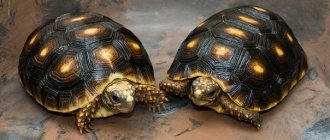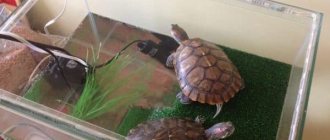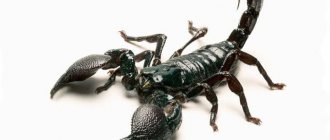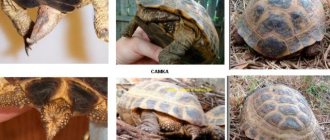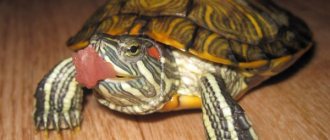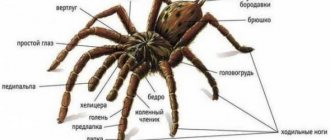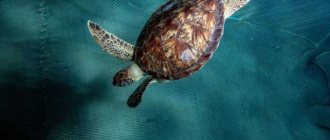The turtle in nature is a representative of the most ancient inhabitants of the planet; the uniqueness of the animal lies in the unusual design of the skeleton, in which the skeletal system is connected to a hard protective shell in the form of a shell. The turtle's shell protects it from the negative influences of the surrounding world and makes it one of the slowest animals on the planet.
In total there are more than 200 species of turtles. Most of them are light in weight and reach several tens of centimeters in length. The weight of large species reaches 700-900 kg, with the main weight concentrated on the shell. The smallest variety weighs 100-200 g. Turtles can live both in the wild and at home. You can learn a lot of useful information about pet turtles here.
Turtle: description, characteristics
- Different species are adapted to their habitat - some prefer water, others live on land. Aquatic reptiles are predators. Their diet includes fish, shellfish, and invertebrates. In nature, the land turtle feeds primarily on plant foods.
- Turtles are long-lived . The average life expectancy is 150-200 years. These animals have inhabited planet Earth for more than 200 million years. In addition to bone shelter from adverse factors, nature has endowed turtles with good eyesight and excellent hearing. When cold weather sets in, turtles go into hibernation.
Elephant
Digestive tract
Through the oral cavity, food enters the wide esophagus, which smoothly passes into the stomach. On the left side of the stomach is the spleen, which produces various blood elements. Then the stomach continues with the horseshoe-shaped duodenum, which seems to envelop the pancreas. The pancreas is an organ that produces enzymes necessary for the process of digesting food. The small intestine passes into the large intestine, which ends in the cloaca. It is located outside the tail. Their gastrointestinal tract is quite long. This is necessary for longer digestion of consumed plant foods. The digestive organs also include the liver and gall bladder, the duct of which opens in the thickness of the duodenum.
The benefits of turtles in nature
- In nature, the turtle is a natural link in the food chain. In ancient times and in the modern food industry, turtle meat is used for cooking.
- Turtle shell is used for decorative purposes and in jewelry production. The symbolism of turtles is used in mythology, art, and heraldry.
- Turtles are representatives of the oldest species of animals and record holders for longevity. Unique animals deserve human care.
Turtle body structure
- Turtles have very well developed limb muscles. The mammal travels long distances on its 4 legs, carrying a huge heavy shell.
- The animal's head has a streamlined shape for comfortable camouflage inside the shell. In most varieties, the eyes are located on the sides of the head and directed towards the bottom. Food absorption occurs with the help of a hard front beak.
- In land turtles, the forelimbs are adapted for digging, and the hind legs allow them to push a heavy shell forward. In freshwater species, dense membranes are formed on the paws, connecting the toes into fins. Movement in water occurs mainly with the front paws, so their size is significantly larger than the hind paws.
- All types of turtles have a small , pointed tail. Several exotic species have a conical spine at the tip. The cervical and caudal sections of the spine are movable, the rest of the skeleton is connected to the shell.
Structure
Natural enemies of land turtles
Photo: Land turtle
Despite reliable protection in the form of a hard shell, turtles have many enemies in nature. Birds of prey (hawks, eagles) hunt them and drop them from a height onto rocks, pecking out their entrails. Crows, magpies, and jackdaws can completely eat barely hatched babies. There have been cases when foxes threw turtles from cliffs onto stones in order to then split their shells and eat them.
In South America, land turtles are hunted very successfully by jaguars. They eat reptiles out of their shells so skillfully that the results of their work can be compared to the activity of a surgeon’s scalpel. At the same time, predators are not content with one turtle, but eat several at once, turning them over on their backs with their paws on flat ground, without grass and stones. Sometimes large rodents, rats, prey on turtles, biting off their tail or limbs. At the same time, the most important enemies of turtles are people who hunt them for eggs, meat, and just for fun.
In addition to predators and humans, the enemies of turtles can be fungi, viruses, and parasites. Often, sick and weak turtles, due to their slowness, become food for ants, which can very quickly gnaw off the soft parts of the body. Some turtles can even engage in cannibalism, eating their relatives if they are unable to escape or resist. As for the giant Galapagos tortoises, given their size and weight, they have no natural enemies.
Interesting fact: Aeschylus, the ancient Greek playwright, died a very ridiculous death. A turtle, picked up by an eagle, fell on his head.
What does a turtle without a shell look like and what is it made of?
- Another unique feature of the turtle is the presence of an internal and external skeleton. The turtle's shell is tightly fused with the ribs and vertebrae; without it, the animal's life is not possible. The presence of a bone structure limits the development of the trunk muscles.
- The thoracic region is lined with oblong vertebrae that pass into the sternum. 33 vertebrae in the turtle's tail , which provide it with mobility. The hip bones are very short and are an integral part of the frame and spine.
- The freshwater turtle is found in nature with a frame made of soft tissues covered with rough skin. Relatively light weight facilitates rapid movement and performs protective functions when encountering danger.
Without a shell
Turtles: what you didn't know about them
Turtles are amazing creatures. We don’t know much about these creatures, but they can present us with many surprises. For example, a turtle's shell contains phosphorus. Therefore, if an animal has been basking in the sun for a long time, it will glow at night.
All turtles perfectly remember human faces and react to a gentle voice by stretching their heads out of their shells. Rude intonations in conversation, in turn, provoke the animal to hide in its “house”.
Large sea turtles are not afraid of encounters with sharks; predators are not able to swallow the animal. Some species of turtles can survive without food for about five years. The record holder for abstinence is the marsh turtle.
turtle shell
- The main feature in the structure of turtles is the shell. The abdominal frame has a flat shape. The bone formation located along the spine has the shape of a semicircle. The upper and lower parts of the shell are connected to each other by bone membranes.
- The surface of the shell is covered with horny scales. Its strength can withstand a load exceeding 200 times the weight of a turtle. The scales of the shell and the rough skin of the body are renewed during the molting process.
- The shell is a reliable shelter . At the slightest threat, the mammal easily transforms the soft parts of the body and hides them under a bone capsule. The neck muscles allow you to completely pull your head inward, leaving only pinholes for breathing outside.
- Any mechanical damage to the shell in the form of abrasions or cracks can provoke a fungal disease. Therefore, despite their external invulnerability, turtles must be handled very carefully.
- Along with its protective functions, a tortoise shell helps to retain heat. Blood vessels pass through it. Due to the many nerve endings, the turtle is able to feel pain and discomfort when mechanically applied to the bone plate.
Shell and skeleton
How does a turtle “mansion” work?
By the way, the owner of a natural “home” cannot exist outside the shell, since the shield is formed by combining the spine and ribs of the chest. It thickens and expands throughout the life of its owner, along with other cells of the body. The bones of the animal seem to merge together. The skin-bone cover is something like a separate chest, which is located on the back and abdomen of the reptile.
Does a turtle have teeth and how many?
- The turtle has no teeth. Chewing food is carried out using horny plates covering the inside of the mouth and pharynx. The textured coating easily handles hard products and grinds plant tubers and stems.
- Excessive salivation contributes to the formation of food lumps, which can remain in the mouth and esophagus for a long time. Promotion of food is carried out using a massive tongue. The limited functionality of the tongue does not allow it to stick out of the mouth.
- In some species of turtles, the tongue is covered with taste buds. Varieties that do not feel taste are less picky about food. Digestion of one turtle meal can take about a week. The functioning of the digestive tract depends on temperature conditions.
Without teeth
The ancestors of turtles: what were they like?
Despite the large number of fossil turtle remains found, scientists still cannot say with one hundred percent accuracy who the ancestor of these animals was. Disputes on this issue are still ongoing in the scientific community. But one thing scientists can say with absolute certainty: the first turtle appeared in the Mesozoic era. This animal had only one half of its shell and a mouth full of sharp teeth. Ten million years later, the turtle's shell was fully formed, but its teeth still remained at this time.
It is known that the fossil ancestors of turtles were incredibly large. They reached a length of more than two and a half meters and had a huge tail. In some specimens it reached the same length as the carapace. There were large needle-like growths at the end of the tail, and long curved horns grew on the skull.
At the moment, zoologists know about twenty-six species of turtles, of which twelve exist to this day.
How does a turtle breathe?
- The turtle breathes through its nasal passages. The openings of the nose are easily visible on the front of the head. Some varieties have a small elongated proboscis.
- Turtles do not have a rib cage , so the voluminous lungs fill the entire upper part of the space under the semicircular shell. The heavier the bone armor, the larger the lung capacity. When inhaling, muscle ligaments and pulmonary muscles contract in the turtle’s body.
- The turtle's breathing is measured. Its frequency depends on the living conditions of the mammal. Freshwater and sea turtles can survive without air for several hours, after which they need to come to the surface of the water and get a new portion of oxygen. Land mammals take about 5 breaths per minute.
- Several species of sea turtles use alternative methods of breathing - through the surface of the skin or special sinuses in the respiratory system. The structural features of the mammalian respiratory system exclude reflex coughing or sneezing. Retention of mucus in the respiratory tract often leads to the development of pneumonia.
Urinary system
The circulatory system forms two closed circles. The heart has three chambers, consisting of two atria and one ventricle, which has an incomplete septum. The right part of the ventricle contains venous blood, which gives it to the pulmonary artery. The middle part, containing mixed blood, leaves the left part of the aortic arch.
Very important arterial trunks that supply the brain, spinal cord and upper limbs of turtles depart from the aorta. These are the carotid and subclavian arteries. The descending aorta gives off many branches supplying blood to the internal organs, stomach, entire intestinal tract, gonads and lower extremities.
Blood from the head leaves through the jugular veins, first collecting in the sinuses. The paired jugular veins flow into the cava; this is the main vein that collects venous blood from all organs. It flows into the right atrium. The entire cardiovascular system of this reptile is very similar to other amphibians.
The upper respiratory tract, and in general the entire respiratory system, begins with the nostrils, which conduct incoming air to the choanae. From the choanae, air is thrown into the mouth and moves further along the larynx. The body of the larynx has three cartilages. After the larynx comes the trachea, which consists of half rings giving it a round shape.
Next, this tube divides into the right and left bronchus, which flow into the lungs. The chest of these animals is immobile, so the act of breathing is carried out only by expanding the lungs themselves. Accessory muscles help them do this. The volume of lung tissue is quite large, which allows turtles to stay under water for a long time.
Turtles have kidneys as an organ for producing and excreting urine. The kidneys are a paired organ located above the pelvic cavity closer to the upper shield. The ureters emerge from the kidneys and open into the cloaca.
The female reproductive organs are represented by ovaries, which do not communicate with the oviducts. The oviduct opens on the anterior abdominal wall with a large funnel. When eggs mature, they fall into the body cavity and then move along the oviduct to the exit.
How to determine the sex of a turtle?
Sexual differences in turtles can only be noticed upon careful examination. External differences between male and female mammals include:
- Shell shape. In females, the shell is elongated into an oblong shape; in males, the shape is more like a flattened oval.
- Plastron shape. On the lower part of the shell, on the side of the tail, males have a depression that facilitates the process of reproduction. In females in this area the plastron is flat.
- Tail length. The tail of female mammals is elongated and straight. Males have a longer tail and more massive at the base.
- Location of the cloaca. In females, the anus is located at the base of the tail and has a rounded shape. In males, the cloaca, in the shape of an elongated seed, is located in the lower third of the tail.
- Nail length. Males have much longer nails on their front paws than females. This feature is a convenient tool for mating.
Determination of gender
Where do turtles live in nature?
- Marine species of turtles live in seas and oceans. Heat-loving animals prefer tropical and temperate climates. The animal cannot survive on cold continents, so it chooses areas with warm open currents and coastal waters. To access air, sea turtles stay close to the surface of the water and often become a catch for people.
- Land turtles prefer areas with arid climates. Animals inhabit desert and steppe lands in southern Europe, Australia, America, and Africa . Several species live in tropical rainforests. In mountainous areas you can meet a turtle at an altitude of 1-1.5 km. There are about 60 species of land reptiles.
- Freshwater turtles live in Europe and Asia near various freshwater bodies. Small rivers, lakes, and seasonal reservoirs are preferable. Freshwater turtles in Russia are found naturally in the regions of the North Caucasus.
- The unusual red-eared turtle is found naturally in North and South America. In Italy they are considered plant pests. You can learn more about the red-eared slider here.
- The snapping turtle , which can bite humans, is found in Canada and the United States. The large green turtle lives in the seas of the Pacific and Atlantic oceans.
What do turtles eat in the wild?
- Turtles are omnivores. The diet of sea and freshwater turtles consists of fry of fish, crustaceans, mollusks, and tadpoles. Large individuals hunt large fish and frogs. A hungry turtle is capable of eating a defenseless relative.
- Land turtles eat mainly plant foods. Animals eat plant stems, vegetables, fruits, and mushrooms. Under favorable conditions, it is not averse to feasting on small insects and small living creatures from reservoirs.
Nutrition
- Rotten food is easier to chew, so turtles do not refuse rotten fish and spoiled fruits.
- At home, pets replace their usual food with algae, salad leaves, vegetables, aquarium fish and snails.
How do turtles reproduce and are born?
- During the breeding season, the turtle's behavior can be used to determine its sex. Interested males surround females with obsessive attention, discouraging her from rivals. The behavior of males is marked by rhythmic shaking of the head and touching the female’s face with the forelimbs.
- The female behaves more indifferently. When the female ignores the male, he begins to bite aggressively.
- Depending on the living conditions, puberty of turtles occurs at different ages. Freshwater turtles are ready to bear offspring at 6-8 years of age , while land turtles lay eggs at 10-15 years of age.
- Mating can occur both on land and in water. The duration of sexual intercourse is a quarter of an hour. The male is pressed against the female due to the concavity of the lower part of the shell. Fixes the position by clinging with tenacious claws or hugging with flat flippers.
Birth
Origin of the species and description
Photo: Land turtle
Scientists have established that turtles descended from one of the ancient extinct groups of reptiles, the code name of which is the Permian cotylosaurs. The extinct reptiles were very similar in appearance to lizards. They had short, but at the same time very powerful and wide ribs, which over millions of years of evolution turned into a shell. These were sea animals that had a rather long neck and a long tail. The ancestors of turtles were omnivores - they ate both plant and animal foods. Since their remains are now found on all continents, it is generally accepted that Permian cotylosaurs were very common at one time.
Video: Land turtle
The most characteristic feature of all turtles is the presence of a shell, which serves as protection from enemies. It consists of two parts: abdominal and dorsal. The strength of the shell is very high, since it is able to withstand a load that significantly exceeds the weight of the animal - more than 200 times. Depending on the species, land turtles vary significantly in size and weight. Among them there are both giants, weighing almost a ton with a shell size of about 2.5 meters, and very small, even tiny turtles, whose weight is no more than 150 g, and the length of the shell is 8-10 cm.
Zoologists distinguish two suborders of turtles, which differ in the way they hide their heads under their shells:
- side-necked turtles - hide their head in the direction of the left or right paw (sideways);
- Hidden-cervical - fold the neck in the shape of the letter S.
Types of land turtles:
- Galapagos tortoise. Its mass can reach up to half a ton, and its length can reach up to meters. The size and appearance of Galapagos tortoises depend on their habitat conditions. For example, in arid areas their shell is saddle-shaped; in areas where humidity is high, the shell has the shape of a dome;
- Egyptian tortoise. One of the smallest turtles. Lives in the Middle East. The shell size of males is about 12 cm, females are slightly larger;
- panther tortoise. Lives in northern Africa. The length of the shell is about 80 cm, weight is 40-50 kg. The carapace is quite high, dome-shaped;
- speckled cape. The smallest turtle on Earth. Lives in South Africa and Namibia. The length of its shell is no more than 9 cm, and its weight is approximately 96 - 164 g.
How many eggs does a turtle lay?
- Turtles are prone to fertilization only in comfortable conditions - with favorable ambient temperatures and a full stomach. The active breeding season occurs in spring.
- To protect their offspring, females lay eggs in familiar territory. Warm summer sand near water sources is the most comfortable place for future turtles.
- The gestation period for a turtle's offspring is 1-3 months. Mammals are capable of hatching up to 200 eggs 3-4 times throughout the year. Only a few manage to survive in the wild. Birds, fish, predatory animals, and even people are not averse to eating eggs.
Up to 200 eggs
Why do sea turtles lay eggs at night?
- To lay eggs, a sea turtle needs to get onto land. You can only see a turtle laying eggs in nature at night. To avoid large crowds of people, females prefer the dark. Land turtles are not associated with night time.
- To accurately distribute the clutch of eggs, the turtle digs a deep hole with its hind legs. Eggs are laid in sequence. For convenience, the turtle plunges its hind legs into the depression and evenly places the future offspring.
- The mammal buries the finished masonry with sand, levels the surface with the lower part of the shell and moistens it with its own secretions. This is where the mother turtle's participation ends. The fate of future offspring depends entirely on environmental conditions.
Turtle skeleton: structure (photo)
Who in childhood did not dream of petting a cute turtle and seeing how deftly it hides in its shell house? These animals seem to children to be simply amazing creatures that can slip out of their shells and come back as needed. Can they? Unfortunately, children's cartoons do not reflect reality. After all, turtles are not adapted to exist outside their protective “house”. To understand why, it is necessary to look at the skeleton of a turtle in cross-section and more. This is what we will do today.
How do turtles winter?
- With the onset of cold weather, turtles hibernate. The animal digs an earthen den and falls asleep in it until the climate changes. The hibernation period lasts from the beginning of winter until warm spring.
- For hibernation, the correct temperature and health of the animal are important. Unfavorable factors can lead to illness in the turtle during sleep.
- Thanks to healthy winter hibernation, the animal’s life expectancy increases, hormonal processes are regulated, and excess fat deposits are processed.
Hibernation
Why do turtles live long?
- How long turtles live in nature directly depends on environmental conditions. The main secret of turtles' longevity is that they are cold-blooded animals.
- They do not have to expend energy heating their own body , and, therefore, metabolism occurs at a very measured pace. It has been scientifically proven that a fast metabolism shortens life expectancy.
Turtles eat quite little; a long period without food does not affect the functioning of the body in any way. The infrequent process of digesting low-calorie food reduces the metabolic load on the body; such conditions are favorable for the long life of turtles.
- At home, the life expectancy of turtles is reduced.
- With proper care, a pet can live about 50 years.

